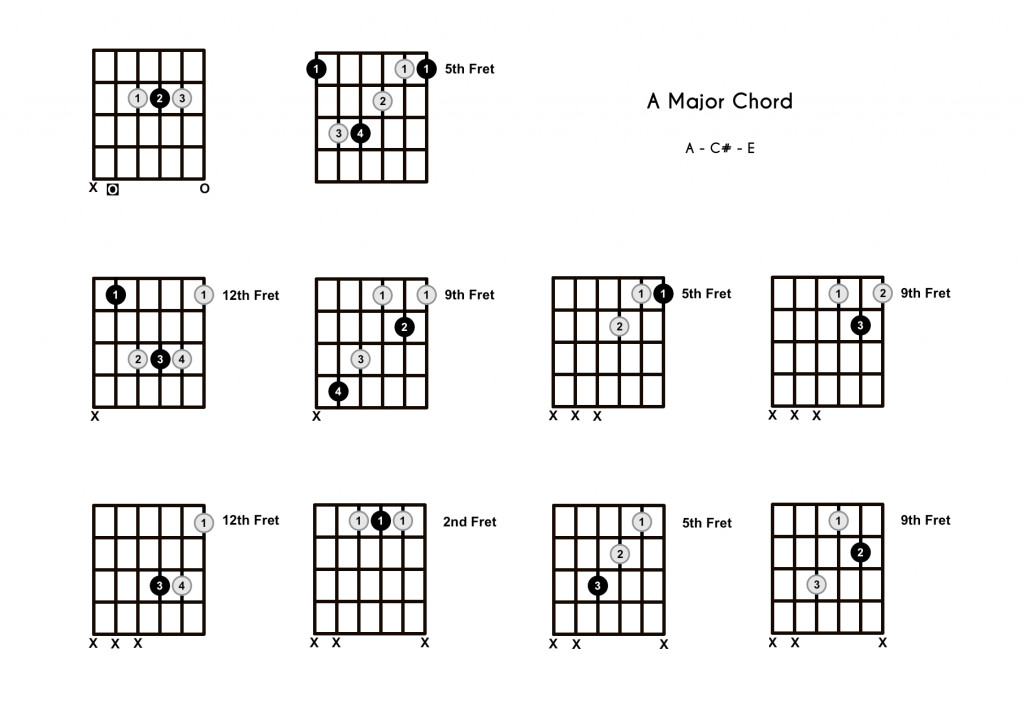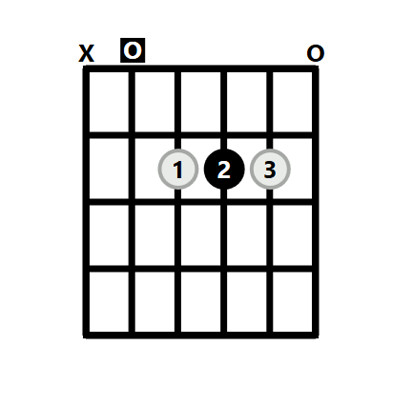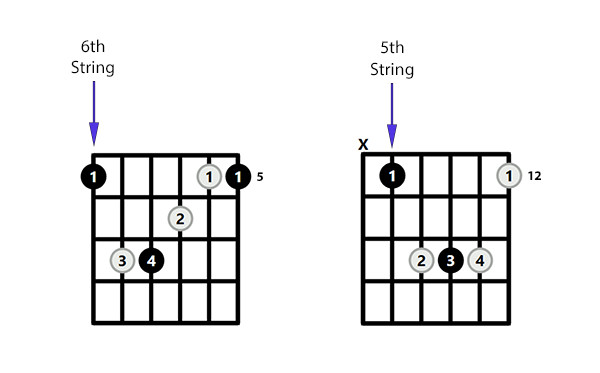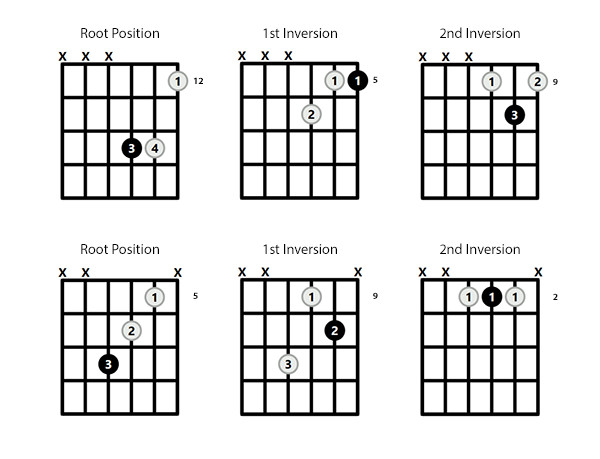The A Major chord is a foundational element for any guitarist, beginner or seasoned player alike. It’s one of the first chords many pick up, and for good reason: the open A chord is accessible, versatile, and rings out with a bright, full sound that’s been the backbone of countless songs across genres from rock and pop to country and blues. Understanding and mastering “A Chords Guitar” – specifically the A Major chord – unlocks a huge part of the guitar playing experience.
Delving into A Major Chord Theory
Before we dive into finger positions and shapes, let’s briefly explore the music theory behind the A Major chord. This understanding will not only help you learn the chord but also appreciate its role in music.
- Notes in the A Major Chord: The A Major chord is built from three core notes: A, C#, and E.
- Scale Degrees: These notes correspond to the 1st (root), 3rd, and 5th degrees of the A Major scale.
- Interval Structure: Like all Major chords, the A Major chord is defined by specific intervals from its root note (A): a Major 3rd (C#) and a minor 3rd (C# to E), which combined create a Perfect 5th interval (A to E).
- Chords in the Key of A: If you’re playing in the key of A Major, the A chord is your tonic, or home chord. It naturally harmonizes with these chords within the same key: A Major (I), B minor (ii), C# minor (iii), D Major (IV), E Major (V), F# minor (vi), and G# diminished (vii°).
Understanding these theoretical elements provides a deeper connection to the music you play and helps in learning related chords and scales.
10 Ways to Play the A Major Chord on Guitar
Variety is the spice of guitar playing! While the open A chord is fundamental, exploring different voicings and positions will expand your musical palette. Here are 10 shapes for the A Major chord to get you started:
 A Chord Guitar – 10 Shapes
A Chord Guitar – 10 Shapes
Various diagrams illustrating 10 different shapes for playing the A Major chord on guitar, showcasing the versatility and multiple positions available across the fretboard.
The Essential Open A Chord Shape: A Beginner’s Starting Point
The open A chord is usually the first version of “a chords guitar” that beginners learn. Its simplicity and full sound make it incredibly rewarding to play early on.
 Easy A Chord Guitar
Easy A Chord Guitar
Diagram showing the easy-to-play open A Major chord shape on guitar, a fundamental chord for beginners with finger positions clearly indicated on the fretboard.
Step-by-Step Guide to Playing the Open A Chord
Let’s break down how to form this essential chord:
- Finger 1 (Index Finger): Place your index finger on the 2nd fret of the 4th string (D string).
- Finger 2 (Middle Finger): Place your middle finger on the 2nd fret of the 3rd string (G string).
- Finger 3 (Ring Finger): Place your ring finger on the 2nd fret of the 2nd string (B string).
- Strumming: Strum downwards across the top five strings (from the 5th string, A string, down to the 1st string, high E string). Avoid strumming the 6th string (low E string) for this chord shape.
Following these steps carefully is crucial, especially when you are first learning. If the chord doesn’t sound quite right, revisit these instructions and ensure each finger is correctly placed and applying enough pressure just behind the fret.
Barre Chord Versions of the A Major Chord
As you progress, barre chords become essential for playing chords in different positions up the neck. The A Major chord is readily playable as a barre chord in two common shapes:
- E Shape Barre Chord: Use the root 6 barre chord shape (based on the open E Major shape) starting on the 5th fret. This places the root (A) on the 6th string, 5th fret.
- A Shape Barre Chord: Utilize the root 5 barre chord shape (based on the open A Major shape, but barred) beginning on the 12th fret. This position has the root (A) on the 5th string, 12th fret.
 A Barre Chord Guitar
A Barre Chord Guitar
Diagram illustrating the A Major barre chord on guitar, showing both the E-shape and A-shape barre chord positions for playing the chord higher up the fretboard.
Barre chords provide flexibility and allow you to move chord shapes up and down the neck, which is vital for playing in different keys and creating chord progressions.
Exploring A Major Triads
Beyond the standard chord shapes, understanding triads opens up new sonic possibilities. Triads are three-note chords that form the foundation of harmony. The A Major triad, in its basic form, contains the same notes as the full A Major chord: A, C#, and E. However, triads can be voiced in different inversions, offering subtle variations in sound.
- Root Position: A – C# – E (Root note is the lowest)
- 1st Inversion: C# – E – A (Third is the lowest)
- 2nd Inversion: E – A – C# (Fifth is the lowest)
Here are a few ways to play A Major triads across the guitar fretboard:
 A Major Triad Guitar
A Major Triad Guitar
Diagram displaying various positions for playing the A Major triad on guitar, including root position and inversions, offering a more melodic and less dense voicing of the chord.
Learning triads enhances your understanding of chord construction and provides a more melodic approach to playing “a chords guitar.”
Keys That Feature the A Major Chord
Knowing which keys naturally include the A Major chord is crucial for songwriting and improvisation. The A Major chord is a diatonic chord (meaning it naturally occurs within the key) in the following major and minor keys:
- A Major: (A, Bm, C#m, D, E, F#m, G#dim) – A is the tonic (I) chord.
- E Major: (E, F#m, G#m, A, B, C#m, D#dim) – A is the subdominant (IV) chord.
- D Major: (D, Em, F#m, G, A, Bm, C#dim) – A is the dominant (V) chord.
- F# minor: (F#m, G#dim, A, Bm, C#m, D, E) – A is the relative Major (III) chord.
- C# minor: (C#m, D#dim, E, F#m, G#m, A, B) – A is the subtonic (VI) chord.
- B minor: (Bm, C#dim, D, Em, F#m, G, A) – A is the subtonic (VII) chord.
Understanding these key relationships helps you build chord progressions and understand how the A chord functions harmonically in different musical contexts.
Alternative and Useful A Chord Shapes
While the open A and barre chord shapes are the most common, exploring alternative shapes can add color and interest to your playing. These shapes may not be used as frequently, but they offer unique voicings and can be very useful in specific musical situations. Experiment with different shapes to find those that resonate with your ear and fit your playing style.
Chord Substitutions for A Major
The A Major chord is harmonically rich and can often be substituted, or enhanced, by related chords. Consider these substitutions to add variation to your progressions:
- A sus4: Creates a suspended, unresolved sound, often resolving back to A Major.
- A sus2: A brighter, more open sound than A Major.
- A add9: Adds a 9th interval, creating a richer, more complex Major sound.
Conversely, the A Major chord itself can sometimes act as a simplification for more complex chords with A as the root, such as A Major 7 or A7 chords (though it cannot substitute for minor chords).
Scales for Soloing and Improvising Over A Chords
To create melodies and improvise over the A Major chord, certain scales work particularly well. These scales complement the A Major tonality and provide the notes you need to solo effectively:
- A Major Scale: The most fundamental scale, perfectly outlining the A Major sound.
- A Major Pentatonic Scale: A simplified Major scale, great for melodic improvisation.
- A Lydian Mode: A Major scale with a raised 4th, creating a brighter, more ethereal sound.
Experiment with these scales to develop your lead guitar playing over A Major chord progressions.
Further Exploration
Deepening your understanding of chords is a continuous journey. To further expand your chord knowledge, explore resources like:
 Get Guitar Chords Galore eBook
Get Guitar Chords Galore eBook
Continue practicing “a chords guitar” and exploring its many facets. The A Major chord is a cornerstone of guitar playing, and mastering it will significantly enhance your musical abilities.
